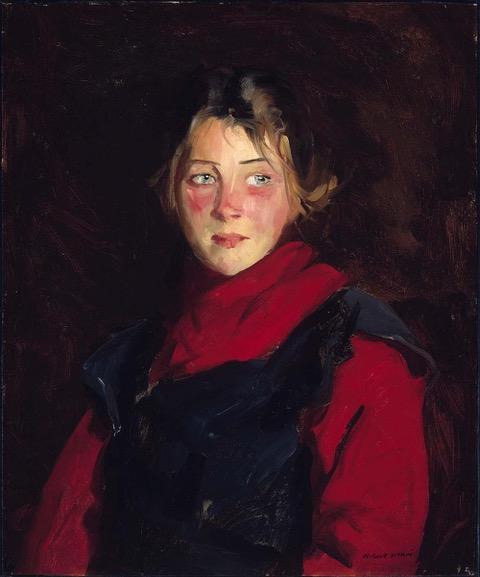June 22, 2021

Robert Henri (1865-1929) wrote of his portrait of Mary O’Donnel that she was “shy and speechless in the presence of strangers” but was a sight to be seen racing around the island on horseback and gathering sea grass.
The girl’s auburn tresses, roseate wind-kissed complexion, and startlingly blue eyes remain frozen in time. From the moment over a century ago that the famed American artist Robert Henri (1865-1929) immortalized her on canvas on Achill Island, Mary O’Donnel’s pretty and innocent visage testifies to a remote Irish landscape that, art historian Margaret Stenz writes, for the painter “was a scene out of [J.M. Synge’s] ‘The Playboy of the Western World.’” This haunting image of a vanished Ireland resides today not in a Dublin museum, but in an erstwhile Proper Bostonian bastion—the Museum of Fine Arts.
Robert Henry Cozad was born in Cincinnati, Ohio, in 1865, his father, John Jackson Cozad, a suave, itinerant professional gambler with a sizable ego and a knack for making enemies. The father shot and killed a man over a financial dispute in the Nebraska town of Cozad, which he had founded and named for himself. Although he was judged to have acted in self-defense, the prospect of the dead man’s family hunting down Cozad sent him, his wife, and his children fleeing the region and heading eastward. Later, Robert Cozad and several of his siblings adopted new surnames in hopes of distancing themselves from their father’s checkered reputation. Robert Henry Cozad changed his name to Robert Henri (pronounced Hen-rye).
A gifted artist from an early age, Henri honed his burgeoning talent first at the Pennsylvania Academy of the Fine Arts and then at the prestigious Academie Julien in Paris. By 1891, he had earned admittance to the vaunted Ecole de Beaux Arts, and he was splitting his time between schools he ran in Paris and Philadelphia, where he married Linda Craige, one of his students.
Henri experienced a breakout year in Paris in 1899, when five of his paintings were awarded space on the walls of two of the city’s foremost galleries. He returned to the United States with his reputation as one of the art world’s rising stars taking shape. In 1905, however, the death of his wife after a string of illnesses and a miscarriage devastated the painter.
Three years later, two profound events, one personal, the other professional, changed the course of Henri’s life. The 42-year-old artist fell in love with and married 22-year-old Irish-born Marjorie Organ, a student at his school in New York. That same year, 1908, he and seven other painters dubbed “The Eight” sent tremors through the art world with gritty works capturing images of America’s poor. This effort was in keeping with his portraits of rural peasants and impoverished city dwellers in Spain, France, the Netherlands, and Ireland during summer sojourns to Europe.
In the summer of 1913, the couple was traveling in Ireland and took a detour to Achill Island. There they befriended local Pat Sheridan, a noted seascape painter and the owner of the Slievemore Hotel, in Dugort. Sheridan and the island’s rugged beauty persuaded the Henris to stay the summer. The artist, captivated by the island’s faces, began a love affair with Achill that would last for years. His enthusiasm was stoked in large part by a friendship with elderly islander Brian O’Malley, a man who knew every inch of the island.
Most summers they rented Corrymore House, a vast, brooding residence near Dooagh and Keel once owned by the infamous Captain Charles Boycott, an English land agent who was ostracized by the natives of the island for his work on behalf of Great Britain. His legacy is the name given to the practice of withholding purchase of certain goods for one cause or another. Henri and his wife bought the mansion in 1924 and returned there for four consecutive years.
He painted portraits of dozens of the island’s people and was especially determined to render with brush oil the faces of Achill’s children. In his book “The Art Spirit,” he declared: “If you paint children you must have no patronizing attitude toward them. Whoever approaches a child without humility, without wonderment, misses in his judgement of what is before him….Paint with respect for [the child]….[The child] is the great possibility, the independent individual.”
In the summer of 1913, Henri brought every aspect of that approach in his portrait of a young girl named Mary O’Donnel, the daughter of Corrymore’s caretakers. He paid her the current “model’s wage” of half a crown, a welcome stipend amid the hardscrabble existence of most of Achill’s families.
In a letter to John T. Spaulding, a renowned Boston art collector who lived in a Beacon Street manse, Henri wrote that Mary was “shy and speechless in the presence of strangers” but was a sight to be seen racing around the island on horseback and gathering sea grass. Enthralled, Spaulding bought the painting in 1921 and eventually donated it to the Museum of Fine Arts. The canvas was the only one of Henri’s works purchased by Spaulding.
While many of Boston’s old guard families were hardly as enamored of “The Irish Girl” as Spaulding, Mary O’Donnel, her shyness notwithstanding, commands attention still as the face of a bygone era of rural Achill Island. She deserves her place among the treasures of the Museum of Fine Arts.

